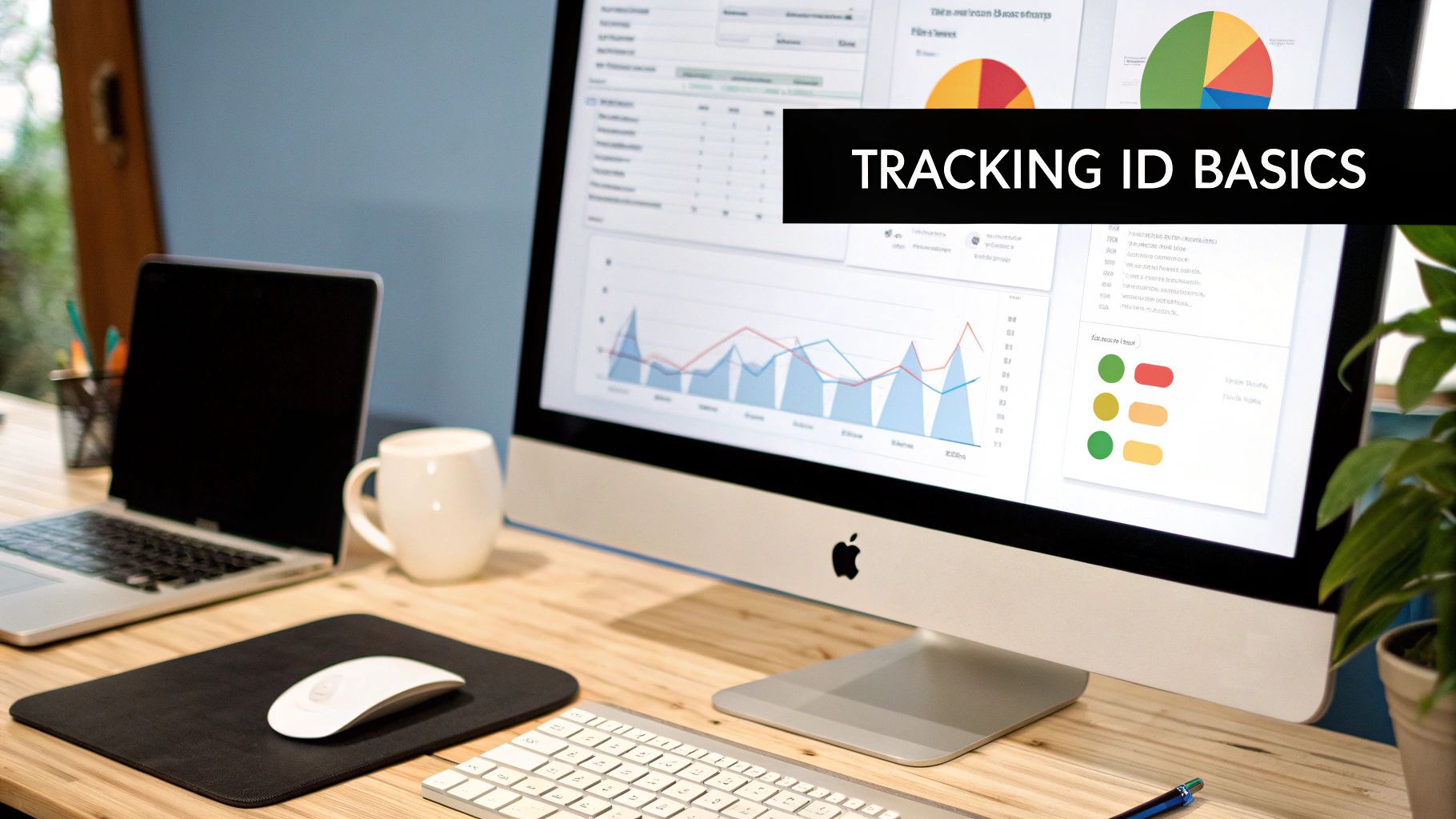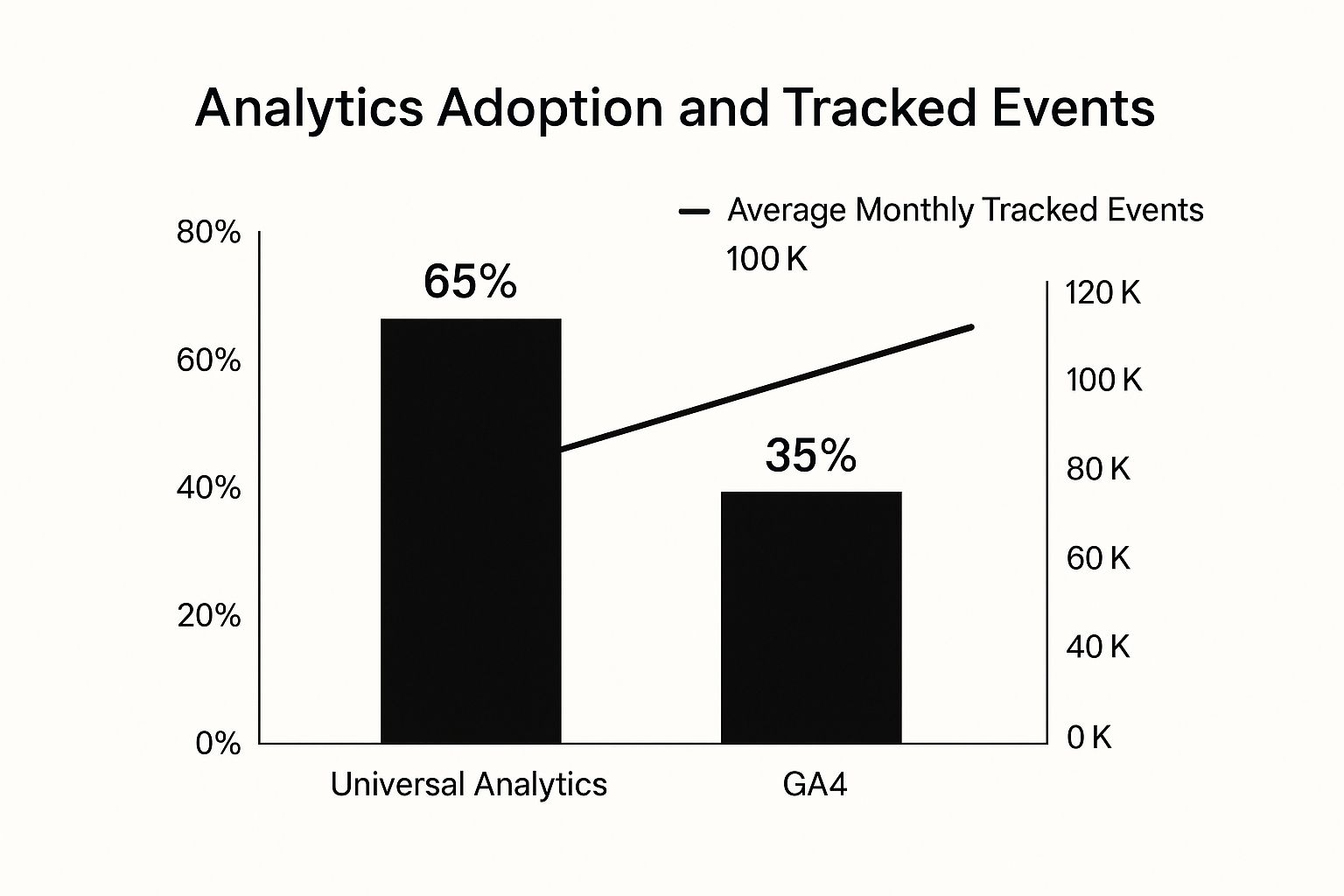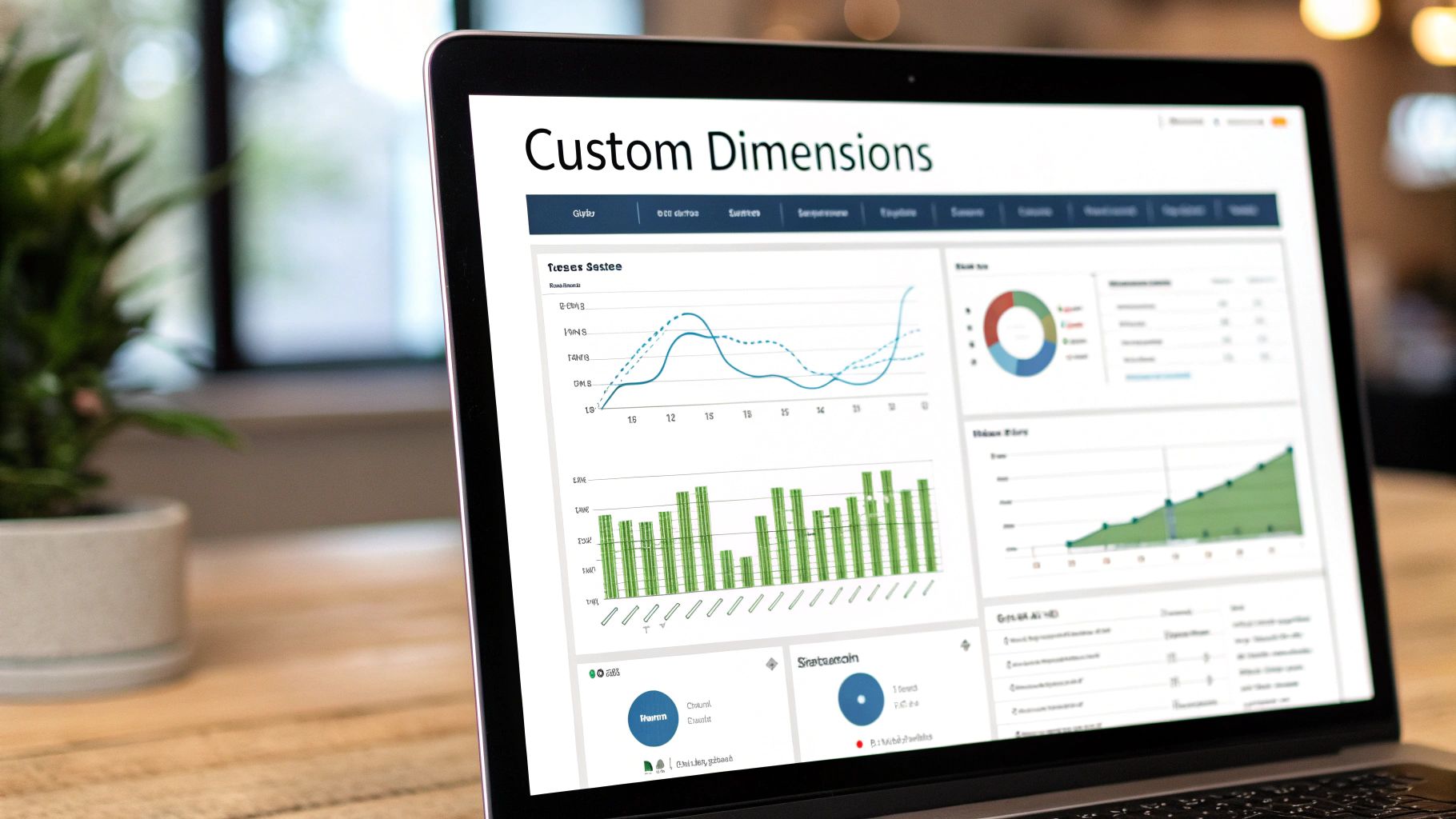
What Is an Analytics Tracking ID?
Share
Think of an analytics tracking ID as your website's unique fingerprint. It's a special code, a string of numbers and letters, that tells tools like Google Analytics "Hey, this is my website. Pay attention to what happens here."
When you embed this ID into your site's code, it acts like a beacon, allowing the analytics platform to recognize your specific property and start gathering data about your visitors. Without it, your website is essentially invisible to your analytics tools, and all that valuable user activity goes unrecorded.
Why Your Tracking ID is So Important

Imagine your restaurant equipment website is a bustling showroom. If you had no way to see who walks in, which aisles they browse, or what equipment they spend the most time looking at, you’d just be guessing at how to improve your store's layout or which products to feature.
An analytics tracking ID does that job for your website, but with incredible precision.
The ID is the core part of a small snippet of code (often called a tag or script) that you place on your site. Once it's there, this script works behind the scenes, watching every visitor's journey. It’s like having a personal shopper for every single person, noting every page they visit, every link they click, and how long they stick around.
This information is then sent back to your Google Analytics account, neatly organized under your unique ID. This is how you know the data you're seeing is only for your website and isn't getting mixed up with anyone else's.
What Does the Tracking ID Actually Track?
With the tracking ID in place, you can start gathering metrics that answer the most important questions for your business. It's the key to understanding who your customers are and what they want.
Here’s a taste of what you can find out:
- Who Your Visitors Are: Learn the basics about your audience, like their general age, gender, and where in the world they're located. Are you attracting local chefs or international distributors?
- How They Found You: See which channels bring people to your site. Is it from Google searches, a link on a partner's site, or your latest social media post? Understanding this helps you see what marketing is working. You can dig deeper by learning what is organic traffic and why it's so valuable.
- What They Do on Your Site: Discover your most popular pages. Do visitors spend more time on commercial oven listings or walk-in cooler spec sheets? You can follow the paths they take, from the homepage to a product page to the contact form.
- Key Business Actions (Conversions): This is where it gets really powerful. You can track when a user completes a critical action, like filling out a quote request for a new fryer or downloading a PDF catalog.
In short, the analytics tracking ID is the bridge between raw, anonymous website traffic and clear, actionable insights. It turns a stream of random visits into a story about your customers' behavior, showing you what works and where you can improve.
If you've been around website analytics for a while, you've seen a major shift happen. The old guard, Universal Analytics (UA), is out, and Google Analytics 4 (GA4) is the new standard. This isn't just a simple update—it's a complete reimagining of how we track what happens on our websites.
For years, we all got used to seeing the classic UA analytics tracking ID, which looked something like UA-1234567-1. Now, we have a new format called a Measurement ID: G-XXXXXXXXXX. This change is more than cosmetic; it signals a fundamental change in philosophy.
Moving From Sessions to Events
The biggest difference is the move from a session-based model to an event-based one. Think of it this way: Universal Analytics was focused on sessions—how long someone stayed, how many pages they viewed. It was like counting how many people walked into your store and for how long.
GA4, on the other hand, is all about events. It tracks specific actions. Did a visitor watch that new convection oven demo video? Did they download the spec sheet for a walk-in freezer? Did they fill out a form to get a quote? Each of these is a valuable "event" that tells you much more about what your customers are actually interested in.
This event-driven approach gives you a richer, more user-focused story. Instead of just seeing disconnected sessions, you can follow the entire customer journey from start to finish.
This is a big deal, especially as the digital world moves away from third-party cookies. The infographic below illustrates just how many websites are still in the process of making this critical switch.

The data makes it clear: while GA4 is the way forward, many are still playing catch-up, which makes understanding this transition essential for anyone managing a website.
To help clarify the differences, let's break down the two types of tracking IDs.
Universal Analytics (UA) vs. Google Analytics 4 (GA4) Tracking IDs
The table below highlights the key distinctions between the old UA Tracking ID and the new GA4 Measurement ID.
| Feature | Universal Analytics (UA) | Google Analytics 4 (GA4) |
|---|---|---|
| ID Format | Starts with UA-, followed by numbers (UA-XXXXXXX-Y). |
Starts with G-, followed by letters and numbers (G-XXXXXXXXXX). |
| Data Model | Session-based, focused on pageviews and user sessions. | Event-based, tracking every user interaction as a distinct event. |
| Focus | Quantifying website traffic and user visits. | Understanding the full customer journey across devices and platforms. |
| Platform | Primarily designed for websites. | Built for both websites and mobile apps, providing a unified view. |
| Primary Use | The main identifier for a UA "property." | The identifier for a GA4 "data stream" within a property. |
This side-by-side comparison shows that GA4 isn't just an upgrade; it's a completely new tool built for the modern web.
The move to GA4 was a necessary one. You can read more about the deprecation of Universal Analytics to understand the full story. Even though GA4 became the official standard in July 2023, the industry is still adapting. As of early 2024, an estimated 14.2 million websites have switched over, but a staggering 44 million are still running the old UA code. It’s a slow but steady migration that’s reshaping how we measure success online.
How to Find Your GA4 Measurement ID
Finding your Google Analytics 4 (GA4) Measurement ID is pretty simple once you know where to look. This special code, always starting with "G-", is how you connect your website to your GA4 account. Think of it as the unique street address for all your website's data—it tells Google exactly where to send everything.
Let's walk through the exact clicks to get you there. You’ll be in and out of the admin panel in no time.
Step-by-Step Guide to Your ID
Assuming you've already created a GA4 property and a web data stream, just follow these quick steps.
- Log in to Google Analytics: Head over to your account and make sure you’re looking at the right property for your restaurant equipment site.
- Go to the Admin Panel: Find the little gear icon labeled Admin at the bottom-left of the screen and give it a click.
- Select Your Data Stream: In the middle column labeled 'Property,' click on Data Streams. This is where your website is listed as a data source.
- Open Stream Details: Now, click on the web data stream for your website.
You'll land on a page that looks just like this, with your ID waiting for you.

Look to the top-right corner of this 'Web stream details' page, and you’ll see your Measurement ID displayed prominently.
Your GA4 Measurement ID is the critical piece of the puzzle. It’s what tells the Google tag on your site which analytics account to send all that juicy user data to.
Go ahead and copy that ID. You’re going to need it for the next part: adding the tracking code to your website, whether you're doing it manually or using a system like Google Tag Manager.
How to Get Your Analytics Tracking Code Installed
So, you've got your GA4 Measurement ID in hand. Now what? It’s time to actually plug it into your website so Google can start gathering all that juicy data. Think of it like this: your website is the new piece of equipment, and the ID is the power cord. You just need to connect them to get things running.
You’ve basically got two main paths you can take here, and the right one really depends on how deep you want to go with your tracking.
The most straightforward way is to use the Google Site Tag (gtag.js). This just means dropping a small piece of JavaScript code directly into the header section of your website. It's quick, dirty, and gets the job done for basic tracking. If all you need right now are core numbers like page views and where your visitors are coming from, this is a perfectly fine place to start.
And if your restaurant equipment site runs on WordPress, it gets even easier. A tool like the MonsterInsights plugin can handle all the heavy lifting, letting you add your tracking code without having to touch a single line of code.
The More Scalable Approach: Google Tag Manager
For anyone who plans on getting serious about their digital marketing, Google Tag Manager (GTM) is the way to go. GTM is essentially a container that holds all your different tracking codes. Instead of cluttering your site's code with individual snippets for Google Analytics, Google Ads, a Facebook Pixel, and so on, you just install the GTM code once.
After that one-time setup, you can add, remove, and tweak all your other tags directly from the Google Tag Manager dashboard, without ever needing to bug your web developer again.
This approach gives you a ton more power and flexibility. It lets you track way more than just page views. Want to know how many people download the spec sheet for that new commercial freezer? Or how many click the "Request a Quote" button on your Hobart mixer page? GTM makes setting up that kind of detailed tracking possible.
This isn't just a "nice-to-have" feature; it's big business. The product analytics market, which is built on this very kind of detailed user data, is on track to hit USD 22.74 billion by 2030. That number alone shows you how much value companies get from truly understanding what people are doing on their websites. Discover more insights about the product analytics market.
Ultimately, the choice between gtag.js and GTM boils down to your ambitions. If you just want simple stats, the direct tag works. But if you want a powerful, scalable system that can grow with your business and give you deep insights, GTM is the professional standard.
Why Analytics Tracking Is a Business Superpower

An analytics tracking ID is so much more than a simple visitor counter. It’s what turns your website from a static online brochure into a dynamic business intelligence machine.
Think of it like installing security cameras in your brick-and-mortar showroom. Without them, you just know people came in. With them, you can suddenly see which pieces of equipment they gravitate towards, the paths they take through the aisles, and where they seem to get stuck or just lose interest and walk out.
For a restaurant equipment supplier, this kind of insight is gold. You stop guessing and start making decisions based on actual customer behavior. You can see with crystal clarity which products, like your commercial refrigerators or high-capacity deep fryers, are capturing the most attention online.
Turning Clicks into Customers
Once you have your tracking ID in place and the data starts rolling in, you can answer some of the most critical questions that directly affect your sales.
- Identify Your Best Performers: You can finally pinpoint which pages and products are your true superstars. If that blog post you wrote about choosing the right commercial oven is driving dozens of quote requests, you know exactly what kind of content to create next.
- Optimize the User Journey: See the exact points where potential customers are leaving your site. If a huge number of people are abandoning their shopping carts right after seeing the shipping costs, it’s a clear signal that it might be time to rethink your delivery pricing.
- Measure Marketing ROI: Stop wondering which marketing efforts are working. Your analytics will show you precisely which channels—be it organic search, your email newsletter, or social media ads—are bringing in not just traffic, but actual paying customers.
This process is all about translating abstract data points into actionable insights. It’s the difference between knowing people visit your site and knowing why they visit and what motivates them to buy.
Ultimately, getting a handle on this data is how you prove the value of your entire digital strategy. For a closer look at connecting data to results, check out our guide on how to measure SEO performance. It’s how you stop throwing money at marketing that doesn’t work and start doubling down on what truly does.
Common Tracking Mistakes and How to Fix Them
Getting your analytics tracking id set up is a massive win, but it's surprisingly easy to make a small mistake that renders all that juicy data useless. In fact, collecting bad data can be even more damaging than collecting none at all, because it can point your business strategy in the completely wrong direction.
One of the most frequent slip-ups we see is the installation of duplicate tracking codes. This often happens by accident—maybe you add the code snippet directly to your site’s theme, and then also add it through a tool like Google Tag Manager or a WordPress plugin. The result is a mess. Every visit, every click, every action gets counted twice, completely blowing up your traffic numbers and destroying the reliability of your reports.
Keeping Your Data Squeaky Clean
Another classic mistake is a simple copy-and-paste error: using the wrong ID on the wrong website. If you're managing a few different online properties, it’s all too easy to grab the analytics tracking id from Site A and accidentally install it on Site B. This cross-contaminates your data, mashing together user information from two separate businesses into one confusing, unusable pile.
To avoid these headaches, run through this quick checklist:
- One Code to Rule Them All: Double-check that your website has only one instance of your GA4 tracking code. You can use your browser’s developer tools or a tag assistant extension to scan for duplicates.
-
Match the ID: Make sure the Measurement ID on your website (it will look like
G-XXXXXXXXXX) is the exact same one shown in your Google Analytics data stream settings. -
Cover All Your Bases: The tracking script needs to be on every single page of your site, usually in the
<head>section. If it's just on your homepage, you’re flying blind to what users do everywhere else.
A clean data foundation is non-negotiable. Taking a few extra minutes to audit your setup prevents you from making strategic decisions based on faulty intelligence, safeguarding your marketing investments. You can learn more about how clean data helps in our guide on how to track keyword rankings.
This obsession with correct identification isn't just an analytics thing, either. The wider identity analytics market—which uses similar tracking concepts for security and verification—is expected to explode to over $16.3 billion by 2035. It just goes to show how critical accurate digital tracking has become for every part of a business. Read the full research about identity analytics growth.
Got Questions About Tracking IDs? We’ve Got Answers.
Jumping into the world of web analytics can feel like learning a new language. It's totally normal to have a few questions. Let's clear up some of the most common ones about tracking IDs so you can move forward with confidence.
Can I Use the Same Tracking ID on Multiple Websites?
This is a common question, and the answer is a firm no. Think of it like a mailing address—you wouldn't send mail for two different houses to the same address and expect it to get sorted correctly.
Each of your websites needs its own unique GA4 Measurement ID. If you use the same one, all the data from every site will get dumped into one big, messy pile. This makes it impossible to see how each individual site is performing, which defeats the whole purpose of analytics.
What’s the Difference Between a “Tracking ID” and a “Measurement ID”?
Great question. This is really just a matter of old versus new terminology.
-
Tracking ID is the name from the older system, Universal Analytics. You'll recognize its classic format:
UA-XXXXXXX-Y. -
Measurement ID is what we call it now in the current system, Google Analytics 4. It looks like this:
G-XXXXXXXXXX.
They do the same job—connecting your website to your analytics account—but they belong to different generations of the tool.
Will the Analytics Tracking Code Slow Down My Website?
Worried about site speed? That’s smart. The good news is the Google Analytics script is built to be incredibly lightweight.
It’s designed to load asynchronously, which is a technical way of saying it loads in the background without holding up the rest of your page content. The impact on your site's speed is almost always unnoticeable, and it’s a tiny price to pay for the treasure trove of data you get in return.
One quick but important note: If you still have the old Universal Analytics (UA) code on your site along with the new GA4 code, you're asking for trouble. This setup can create major data headaches, like double-counting visitors and inflating your traffic numbers. The best move is to fully switch over to GA4 and remove that old UA code for good. That way, you know the data you're using to make business decisions is clean and accurate.
Ready to stop guessing and start using your website data to drive real sales? At Restaurant Equipment SEO, we live and breathe data-driven marketing for businesses like yours. Let us show you what's possible when analytics powers your growth.
Learn more about our approach at https://restaurantequipmentseo.com.